Meteor Scatter obervations by Peter Bus (DMS) and Wim Zanstra (DMS)
Radar observations by Jiri Borovicka (Ondrejov)
Some GIA's meteors appeared on Oct. 8/9 night. K.Osada saw 5 GIA's meteors during 45 minuts around 11hUT. M.Sakaguchi saw 6 GIA's meteors during 75 minuts around 11hUT. K.Osada and M.sakaguchi successed to detect its radiant. On the other hand, C.Shimoda witnessed -1 Mag GIA's meteor at 14h04mUT. However, there were no GIA's shower activity by HRO. I can't observe any GIA's shower because of cloud.
-----------------------------------
thashi@din.or.jp Hashimoto, Takema
Minor Meteor Shower Circular(MMSC)
URL : http://www.din.or.jp/~thashi/index_E.htm
-----------------------------------
Nippon Meteor Society (NMS)
Association of Meteor Observers in and around Tokyo Area (AMOTA)
-----------------------------------
Just a quick message to inform you that I just observed a low level but definite activity of the Draconids (Giacobinids) from The Netherlands, confirming earlier messages from mr. Hashimoto (Japan).
Weather is very bad here due to a large frontal system over Northwest Europe, but to my amazement I had a few clearings here last hour. In two periods of clear sky (19:59-20:20 UT and 20:38-20:58 UT) with Lm at +6.3, I observed a total of 11 meteors, of which 5 were Draconids, although admittedly one of these is a little bit a 'perhaps' since it appeared in the corner of my eye with a DCV of 40, making the plotting slightly ambiguous (all meteors have been plotted). In addition, I noted a 6th Draconid during 'unofficial' time with a partly clouded sky, at 20:31 (+3). Draconids seen were faint, +3 to +4.
It is now clouded again, but next two hours I keep on vigil for new clearings (after that, the radiant comes to low).
Anyway, a low level but definite activity I suggest! Observers at more western longitudes, please keep an eye open next hours!
Marco Langbroek
Dutch Meteor Society (DMS)
The Netherlands
Very Preliminary report
It seems there was probably some Giacobinid/Draconid activity. Despite the unfavourable antenna-geometry between 17 and 21h UT, the number of long duration reflections ( >1 sec at 72.11 MHz) was about 2 a 3 times higher than 'sporadic' activity in previous days.
Pieter Eisse Bus
Dutch Meteor Society (DMS)
Groningen, the Netherlands
Secondary report of GIA shower observation in Japan, 1999.
Kazuhiro Osada
Site : Oyama ,Shizuoka, Japan 138d58m , +35d20m
Xi Gamma
DATE UT TIME aM Spo. GIA NTA STA ORI Cet Cet Lm CL Dir Obs.
----------------------------------------------------------------------
1999 Oct.
08/09 11:30-12:23 53 37 30 6 0 0 - 1 0 5.5 2 Z OSAKA
08/09 12:45-14:00 75 44 33 8 1 0 1 1 0 5.8 2 Z OSAKA
08/09 14:00-15:00 60 39 27 4 2 1 3 2 0 5.7 1 Z OSAKA
Time : Observed time interval
Total: Total number of meteors
Spor.: Number of Sporadic meteors
GIA : Giacobinid meteor shower
Lm : Limiting magnitude of field stars
CL : Cloud cover
Dir : Observation direction(Z:Zenith)
Note : Xi-Cet and Gamma-Cet are a one of the Taurid complex in Japanese.
Magnitude distributions
+------+---------------------+----+----+-------+
| | -1 0 1 2 3 4 5| all| ave| Lm |
+------+---------------------+----+----+-------+
| GIA | 2 2 4 8 2| 18|3.33|5.5-5.8|
| NTA | 1 1 1| 3|3.67|5.5-5.8|
| STA | 1 | 1|-.--|5.5-5.8|
| ORI | 1 1 2 | 4|2.00|5.5-5.8|
|Xi-Cet| 1 2 1| 4|4.00|5.5-5.8|
+------+---------------------+----+----+-------+
|Spo. | 1 3 5 14 46 21| 90|3.80|5.5-5.8|
+------+---------------------+----+----+-------+
Kazuhiro Sumie
Site : Chikusa platou, Chigusa ,Hyogo, Japan 134d24m , +35d13m
DATE UT TIME aM Spo. GIA Lm CL Dir Obs.
----------------------------------------------------
1999 Oct.
08/09 12:20-13:00 40 15 13 2 6.5 0 Dra SUMKA
08/09 13:00-14:00 60 34 31 3 6.6 0 Z SUMKA
08/09 14:00-15:00 60 38 36 2 6.7 0 Z SUMKA
08/09 15:00-16:00 60 35 35 0 6.7 0 Z SUMKA
Hiroyuki Okayasu observed during 10h30m-12hUT, Ken-Ichi Fushimi also observed
during 13h10m-14h10mUT. There were no GIA's meteor found.
Masayosi Ueda, Kazuhiro Suzuki observed GIA by HRO, they were not able to catch
any especially activity. However, Chigusa High School caught tendency of a few
echo incleasing by HRO.
-----------------------------------
thashi@din.or.jp Hashimoto, Takema
Minor Meteor Shower Circular(MMSC)
URL : http://www.din.or.jp/~thashi/index_E.htm
-----------------------------------
Nippon Meteor Society (NMS)
Association of Meteor Observers in and around Tokyo Area (AMOTA)
-----------------------------------
As reported in two quick e-mail flyers yesterday evening, I've been able to catch some Draconids last night. Below is a table with my data.
Activity was low level but enough stream members appeared to make it clear that the stream was active, rather like the low-level activity we noted from our country in 1998 just a few hours after the main outburst over Japan that year. Like 1998, meteors were faint.
My data suggest a tentative ZHR in the order of 11 +- 5 (period 20-21 UT).
I have been lucky, since the weather conditions are very bad at the moment due to a 'low pressure train' over our part of Europe, resulting in cloud cover and rainshowers. But I was lucky enough to get two serious periods of clear skies, each lasting 20 minutes, within one hour between 19:50 and 21:00 UT, enough to do some vigilant work. I have seen no other visual reports from my country except for a NEGATIVE one by Hans Betlem c.s. who were observing some 10 km to the north for 30 minutes or so, and report seeing NO Draconids (further details like limiting magnitude, cloud cover etc. are lacking currently. They were most likely observing from a site with more light pollution than that of me if they were at the place where I think they were). Peter Bus reports activity between 18-20 UT with Radio MS.
Just a quick narrative about the data below; around 20:30 LT (18:30 UT) I noted some small breaks in the cloud cover at the horizon, much to my surprise since I had just come to terms with the idea of (again) losing this Draconid maximum (we had cancelled our planned campaign due to the bad seemingly hopeless weather prospects). At 19:50 UT it was clear that the cloud cover over my head was breaking too so I assembled my equipment. A Lm estimate at 19:58 UT reached a very good +6.3 in Cep and Dra counting areas, which is a very good Lm for my location, and so I started at 19:59 with a sky that was now completely open (!) except for some clouds in the far distance, a few degrees above the horizon, far away over sea. It became clear that cloud fields over sea seemed to dissolve once coming onto land. 5 minutes later, at 20:04, a faint short slow +4 meteor made a short trail just below beta Lyra, almost in the center of my vision and coming straight from the radiant! That made my heart beat faster. Some sporadics later, a second one (+2, the brightest noted) appeared at 20:18, traveling from Her to Oph just before clouds began to intrude. At 20:20, I was forced to take a break. Since smaller clearings were present I stayed on vigil for any Draconids, in order to note them down. I noted thus one other Draco in 'unofficial' time at 20:31 (+3) with a partly overcast sky (note; table below only gives the 'official' records, i.e. periods without clouds in the sky, thus this 'unofficial' 6th Draco is not mentioned in below table). At 20:37, sky opened again and I again counted a Lm of +6.3. At 20:44 a +4 Draco appeared in the north of Cygnus, but in the corner of my eye so this one might be a little bit uncertain. One minute later, another +3 Draco appeared under the left wing of Cygnus. At 20:50, a thin veil spread across the sky and Lm dropped to +5.9. At 20:57, a fifth ('sixth' if counting the unofficial 20:31 as well) Draco appeared, +3, travelling towards Lacerta. At 20:58 I was forced to stop since clouds now definitely intruded. But anyhow I felt quite satisfied. After all, Draconids are uncommon meteors!
All trails have been plotted on a gnomonic map. Table with data below.
Marco Langbroek
(Dutch Meteor Society)
Date; Oct 8-9, 1999 Obs; Marco Langbroek LANMA loc.; Voorschoten, Netherlands, 52d 07'N, 4d 28'E UT Teff Lm Dra dAur Psc Tau Spo 19:59-20:20 0.32 6.3 2 0 0 0 4 20:38-20:50 0.18 6.3 2 0 0 0 2 20:50-20:58 0.10 5.9 1 0 0 0 0 TOTAL 0.60 <6.3> 5 0 0 0 6 11 strm/mag. +2 +3 +4 +5Draconids 1 2 2 0 3.2 Sporadics 2 3 0 1 3.0
Draconids 1999
Very preliminary report
Observer : Eisse Pieter (Peter) Bus
Location : Groningen, Netherlands (6 degrees 33' E, 53 degrees 13' N)
Frequency : 72.11 MHz
Transmitter
Location : Wroclaw, Poland, 130 kW, distance 740 km
Antenna : Yagi, 3 elements, geographical azimuth 106 degrees (ESE),
elevation 13 degrees.
Receiver : Bearcat UBC 860 XLT Scanning radio, sensitivity 0.5 uV.
Observation
Method : Listening and counting in 5-minute intervals.
Mean "sporadic" activity on September 26, 2, 4 and 5 October 1999.
Between brackets one sigma errors (n-1)
Hour rates starting at UT:
17h 18h 19h 20h
58(18) 75(10) 76(11) 80(6)
Mean "sporadic" activity of long-lasting reflections
(> 1 sec) on 26 September, 2, 4 and 5 October 1999.
Between brackets one sigma errors (n-1).
17h 18h 19h 20h
7(1) 8(2) 7(1) 8(2)
Uncorrected counts observed on October 8, 1999.
Hour rates starting at UT:
17h 18h 19h 20h
59 80 65 100
Uncorrected counts of long-lasting reflections
> 1 sec observed on October 8, 1999.
Hour rates starting at UT:
17h 18h 19h 20h
12 20 13 14
Very preliminary conclusion:
The total amount of monitored reflections shows no significant increased activity. Only the long-lasting reflections (typical in the order of 1-2 sec) shows significant signs of increased activity probably caused by Giacobinids/Draconids.
Peter Bus
'The results' of october 9. Hourrates of all reflections. Between brackets long-lasting reflections >1 sec. Starting at: 17h 18h 19h 20h 64(7) 73(7) 71(9) 86(10) Conclusion: Activity in this period is almost equal to the sporadic background activity. It seems presumable the activity on october 8 is due to the Draconids. Please wait for the final analyses to be published in a couple of days. -Peter Bus
Preliminary results
Observer : Eisse Pieter (Peter) Bus
Location : Groningen, Netherlands (6 degrees 33' E, 53 degrees 13' N)
Frequency : 72.11 MHz
Transmitter
Location : Wroclaw, Poland, 130 kW, distance 740 km
Antenna : Yagi, 3 elements, geographical azimuth 106 degrees (ESE),
elevation 13 degrees.
Receiver : Bearcat UBC 860 XLT Scanning radio, sensitivity 0.5 uV.
Observation
Method : Listening and counting in 5-minute intervals.
It seems presumable that low-level activity of the Giacobinids/Draconids is observed by forward scattering of radiowaves in the period 16h-21h UT on October 8, 1999. The total number of reflections gives no indication of any shower activity. However, the long-lasting reflections > 1 second on October 8 in the period 16h-21h UT rose significantly above back-ground level. The duration of the long-lasting reflections was in the order of 1-3 second, almost equal to the outburst in 1998. Reflections lasting longer than 7 seconds were very rare. Maximum activity occurred around 19h UT ± 10 minutes around Solar Longitude 195°.06 (J2000) almost at the same position of 1998 (195°.075). Visual reports by Japanese observers and the Dutch observer Marco Langbroek indicate low-level Giacobinid/Draconid activity. However, the total number of meteors observed by Radar on October 8 at Ondrejov (J.Borovicka and P.Pridal) shows no statistically significant increase of meteorrates in comparison with previous night.
Figure 1 - Mean "sporadic" activity on September 26, 2, 4, 5 and 9 October 1999 (open circles) and the total activity on October 8 (dots) per 30-minute intervals. There is no significant difference between the mean "sporadic" activity and activity on October 8. The increasing activity after 20h UT on October 8 is probably not caused by Giacobinids/Draconids. However, this increasing activity is also observed of about the same magnitude for the same period in 1998. The mean "sporadic" activity is almost the same as observed in 1998. The bars represent one-sigma errors (n-1).
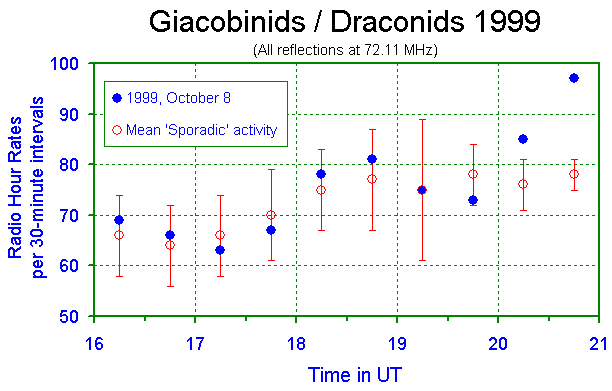
Figure 2 - Mean "sporadic" activity of long-lasting reflections > 1 second on September 26, 2, 4, 5 and 9 October 1999 (open circles) and the activity of long-lasting reflections > 1 second on 1999, October 8 between 16h and 21h UT per 30-minute intervals. The mean "sporadic" activity is almost the same as observed in 1998. The bars represent one-sigma errors (n-1).
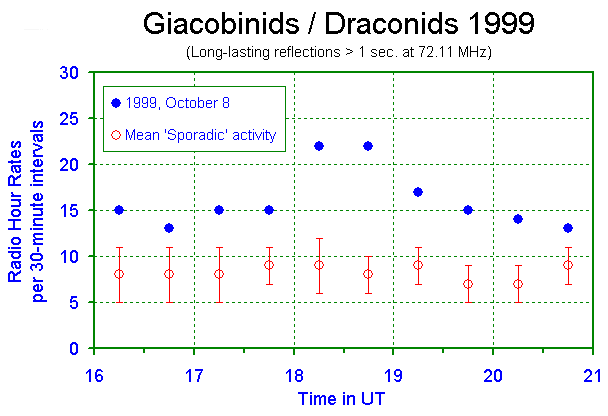
Figure 3 - Meteor Radio Hour Rates only corrected for observability function assuming the activity is caused by Giacobinids/Draconids. Maximum activity is monitored around 19h UT ± 10 minutes around Solar Longitude 195°.06. This is almost the same longitude as observed for maximum activity in 1998 (195°.075). The bars represent one-sigma errors with the errors of "sporadic" activity taken into account. In the period 17h-21h UT on October 8, 1998, the activity of the long-lasting reflections was almost equal to the sporadic background in 1998 and 1999.
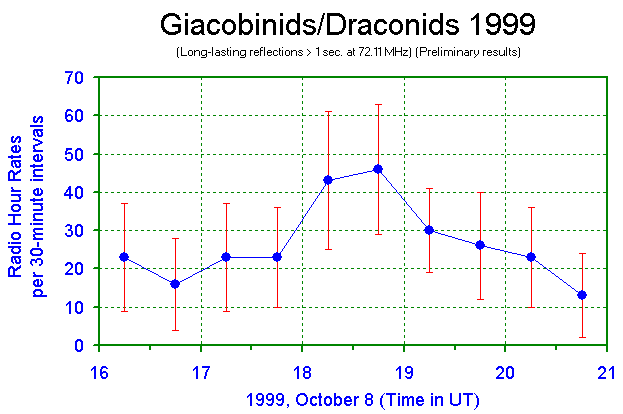
DRACONIDS 1999, 8 October
Observer : W.T. Zanstra
Location : Appingedam, Netherlands (6 degr 51' E, 53 degr 19' N)
Frequency : 72.110 MHz
Transmitter: Wroclaw, Poland (16 degr 43' E, 50 degr 52' N),
distance 735 km, power?
Antenna : 5 elements Yagi, elevation 12 degr, azimut 110 degr (ESE)
Receiver : Bearcat UBC 177 XLT scanner, sensitivity 0.3 microVolt
Observing
method : listening by headphone
DRACONIDS INCLUDING SPORADIC METEORS (forward scattering)
October 8, 1999
n spor
UTC | weak moderate strong >5sec | weak moderate strong >5 sec | Fobs (%)
-----------------------------------------------------------------------------
16 - 17 | 18 7 0 1 | 9 6 1 0 | 0
17 - 18 | 5 7 0 0 | 9 6 1 0 | 0
18 - 19 | 7 10 1 0 | 10 6 1 0 | 0
19 - 20 | 11 13 2 0 | 12 7 1 0 | 0
20 - 21 | 19 12 4 0 | 13 8 2 0 | 8
21 - 22 | 19 8 2 0 | 14 9 2 0 | 36
The numbers (n) are hourly rates, corrected for reflectiontime
and breaks, and including sporadic meteors.
The sporadics (spor) were observed during several years since 1995.
The levels are adapted to recent countings of sporadic meteors.
Fobs is the Hines' observability function.
Draconid activity can be recognized by the increase of the moderate
and strong reflections, and the collapse of the weak reflections,
even during the interval of time when Fobs=0.
Wim Zanstra
Spijkerlaan 13
NL-9903 BB Appingedam
The Netherlands
Tel: ( .. )596.625617
E-mail: wimzanstra@freemail.nl
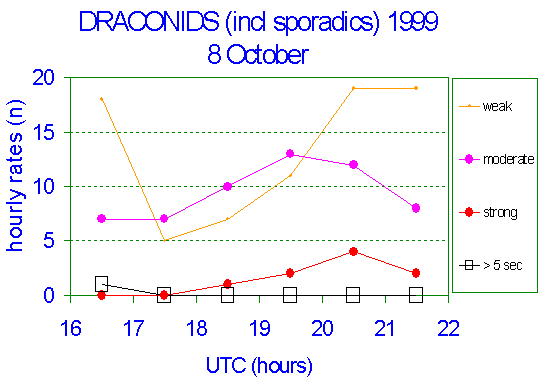
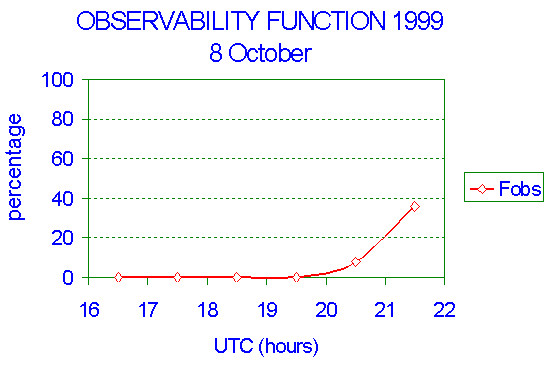
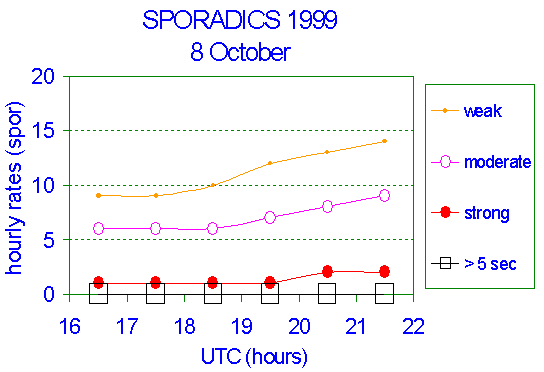
Some Draconids were observed from Croatia (by Senka Pintaric):
Date : 8-9/10/1999 Begin : 20:01 End : 22:58 Location: 16°22`59`` E/W, 46°27`00`` N/S IMO Code: 23003 Place : Dragoslavec Country : Croatia Observer: Senka Pintaric IMO Code: PINSE Shower alpha delta DAU 95° 49° GIA 262° 54° ORI 88° 15° STA 31° 8° NTA 29° 14° Period Field Teff F Lm (UT) alpha delta (h) 20:01-20:57 322° 40° 0,92 1,00 5,60 21:45-22:58 30° 40° 1,12 1,00 5,61 DAU GIA ORI STA NTA Spor. Tot M N M N M N M N M N M N N C 2 C 2 C 0 C 2 C 0 C 9 15 C 0 C 1 C 0 C 2 C 2 C 11 16 Shower -2 -1 0 1 2 3 4 5 6 7 Tot DAU 1 1 2 GIA 2 1 3 ORI 0 STA 0,5 0,5 2 0,5 0,5 4 NTA 1 0,5 0,5 2 Spor 1 1 3 1 4 9,5 0,5 20 Communicated by: Nikola Bilikov